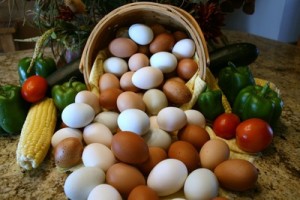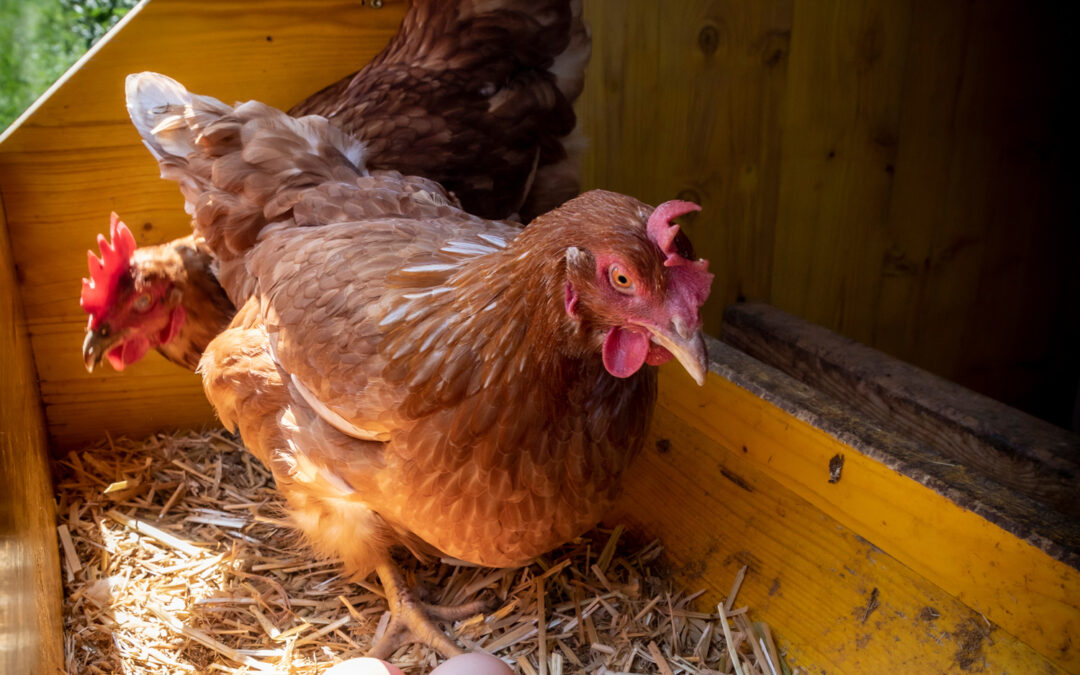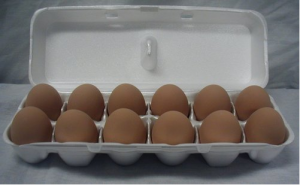
Photo by Steve Taysom
Sometimes you may be getting fewer eggs than you expect, even when your hens are laying well. This can happen if they develop the bad habit of eating their own eggs.
Egg eating can start by accident, sort of. Maybe a hen stepped on an egg and punctured the shell. Or maybe once when you were gathering eggs, an egg slipped from your hand, fell to the floor of the coop and broke. Chickens, quick to eat anything that looks like food, voraciously lap up the white and yolk of the broken egg.
Once a hen has tasted fresh egg and found it to be good, she may start breaking eggs intentionally in order to eat them. Once she’s learned to do that, other hens will learn it from her, and soon you may be very short on eggs.
So how do we prevent this? Or, if egg eating has already become a problem, how do we cure it?
How to Prevent Egg Eating
It’s easier, and more effective, to prevent chickens from eating eggs than to cure egg eating once it has started.
First, make sure that your chickens are getting an adequate and balanced diet with plenty of protein and calcium. Calcium helps form strong egg shells, which are less likely to break. Lack of protein in a hen’s diet can make her more inclined to break and eat eggs.
We recommend that you keep a free choice feeder of ground oyster shells available to your adult layers, and use a good quality layer feed with at least 16% protein. If your chickens have access to table scraps or scratch grains, that will lower the average protein content of their diet, so use these in moderation.
Second, provide plenty of space for your chickens, both in the coop and in the nest boxes. Overcrowding in the coop can cause your chickens more stress and can lead to multiple problems beyond just egg eating. Overcrowded nest boxes increase the likelihood that a hen will accidentally break an egg.
Start with one nest box for every four hens, and adjust from there. You’ll know they need more nest boxes if you often see more than one hen crowded into a nest box at the same time — although hens do tend to all like one nest box!
Place your nest boxes in a darker area of your coop, where the opening doesn’t face direct sunlight. Hens prefer to lay in darker, more secluded areas, so this will encourage them to lay in the nest box rather than somewhere else, and hens are less likely to break open eggs in a dimly lit nest box.
Provide plenty of fresh bedding to form a soft layer in the floor of your nest boxes. This will help protect the eggs from inadvertently being broken.
Third, if you or the chickens ever break an egg in the coop or in an area they can access, clean it up quickly and thoroughly, before they discover it. Remove any egg-soaked bedding. If the broken egg is on the ground, use water to wash away and dilute the egg white and yolk so it can soak into the soil. Remove broken egg shells or crush them into very small pieces so they no longer look like eggs.
While we’re on the subject of eggshells, some people feed their chickens eggshells as a source of calcium. This can be done, but we prefer using ground oyster shells as mentioned above. If you do decide to feed egg shells back to your chickens, wash them thoroughly and grind them into very small pieces so that you don’t encourage a egg eating either by taste or by sight.
How to Cure Egg Eating
As mentioned previously, it’s easier to prevent egg eating than to cure it. It’s not always possible to cure an egg eater, so practice everything discussed above in the Prevention section above.
Gather eggs frequently, as soon after laying as possible. Although it isn’t always convenient, checking for and gathering the eggs several times a day can make a big difference. The longer an egg is left in the coop the more likely it is to get eaten, particularly if only one hen is the culprit.
Use artificial eggs (ceramic eggs work well for this or wooden eggs, or even white golf balls). Ceramic eggs come in white which look like real eggs, or in fun colors, but are much harder than wooden eggs. Gather all the real eggs quickly, but leave a few ceramic eggs in the nest box. As chickens peck, trying to break these eggs, they’ll find them impossible to crack and hopefully discouraging them from eating the real eggs.
Try to identify the egg eater. It’s most obvious if you catch her actually eating an egg, but you may also be able to spot dried yolk on her beak, feathers or comb. Once you’ve identified her, isolate her from the rest of the flock and see if your problem with egg eating in the main flock goes away. Moving the hen disrupts her behavior somewhat and will help to break the habit. Gather eggs quickly and frequently from the isolation coop so that she doesn’t have access to any eggs. If you’re continuing to lose eggs from the main coop, then you may have more than one egg eater that needs to be identified and isolated.
A suggestion from Pat Foreman, author of the book City Chicks, is to block access to the nest box where you found evidence of the broken egg. To do this, you can block the entrance or put something bulky in the nest box to occupy it. This will change the hen’s routine somewhat since she won’t be able to eat egg where she normally would, and according to Foreman, this can be successful in helping to break the pattern of egg eating.



Keep clean nesting material in your nesting boxes help from hens eating eggs. My hens start eating the eggs if the nesting material starts to get a little dirty. I’ve been changing the nesting material more frequently. This has helped a bunch.
I come from many generations of chickens keepers. A handed down method of feeding back eggshells to chickens for calcium, is to break up the eggshells, place them on a cookie sheet, and toast them in the oven until just a little browned. I’ve never had any problems of my hens eating their own eggs using this method. Our local feed stores don’t sell oyster shells because of salmonella problems. Hope this helps.
If you feed whole egg shells to your chickens, they will look like regular eggs and this will actually encourage them to eat their own eggs. I have tried both egg shells and oyster shells for my hens and personally think that they lay better when fed egg shells.
To discourage egg eating, I collect a large number of egg shells in a box, rinsing them with water before placing them in the box, so that all of the egg white is gone. When I have enough shells, I lay them out on a cookie sheet and place them in a preheated 350 degree (F) oven and bake them for 10-15 minutes, or less. I then pulse them in a food processor until they aren’t too fine and aren’t too big.
Calcium concentration and useable levels is fairly low in egg shells. On average they would have to eat six whole egg shells to replace the calcium content of producing one egg. With oyster shell, the useable calcium is at a much higher concentration, its just more efficient.
http://www.the-chicken-chick.com/2013/08/for-strong-eggshells-size-matters.html
I’ve tried all the above methods and it didn’t work. My two hens still get their eggs just as soon as they lay them. I can’t even sit and wait for them to lay them. I’ve tried that, too. I even bought an expensive roll-out pen for them, but the eggs get caught instead of rolling out and they would still get them. I even saw one of them reach her head under the cage, onto the roll-out, and reach the egg.
I read a study last year that put hot sauce or chili powder mixed with vegetable oil in an egg shell and put it in the nest box. The egg eaters didn’t like this and stopped the bad behavior.
I’ve always used roll-out nests where once they lay an egg, they roll down an incline under a trap door. When you gather eggs, you lift that up to pick up the eggs. They can’t get at them. It’s always worked well for me.
Had this problem and tried everything that is mentioned here, except for relocating the offending hens because we couldn’t ever determine the guilty party. Also tried darkening the coop, and even tried the mustard-filled egg — they ate the egg and mustard, and asked for more! This is what worked for us: I took bed sheets and tore them into strips, stapled them to the top of the nest box, and let them drape down over the opening which formed a walk-through curtain. This made it much darker in the nest, and the problem went away.
To combat naughty hens that eat their and others’ eggs, I had to revert to nests like I used 66 years ago, when I had 100 white leghorns on a wire floor. The nests had a sloping floor made of 1/2″ hardware cloth, that extended a foot beyond the back of the nesting area which left a space big enough for an egg to roll under. The flooring past this back wall sloped also, then curled up gently to halt the rolling eggs and collect the eggs out of reach of the hen. The only problem is that if a foot blocks the egg from rolling, it is still in danger, but otherwise the hen is thwarted by the law of gravity.